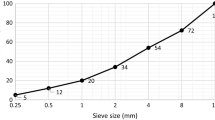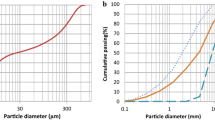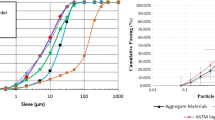Abstract
The type and amount of filler are amongst the most important parameters influencing rheological, mechanical and durability characteristics of self consolidating concrete (SCC). Influence of using a limestone powder, the filler portion of reactive basalt filler and a type of class C fly ash on the fresh properties, alkali–silica reactivity and transport properties were investigated in this study. For this purpose, six SCC mixtures having three filler types and two water/powder ratios were prepared. Alkali–silica reactivity was evaluated by conducting RILEM AAR-3 (38 °C) and AAR-4 (60 °C) concrete prism tests. Besides, the mixtures were exposed to permeable void content, sorptivity and chloride ion permeability tests in order to evaluate the transport properties. According to the results, using a high amount of powder from a reactive basalt in SCC mixture led to the highest expansion level and poor transport properties.








Similar content being viewed by others
References
Okamura H, Ouchi M (2003) Self-Compacting Concrete, Invited Paper. J Adv Concr Technol 1(1):5–15
Choi YW, Kim YJ, Shin HC, Moon HY (2006) An experimental research on the fluidity and mechanical properties of high-strength lightweight self-compacting concrete. Cem Concr Res 36:1595–1602
Brouwers HJH, Radix HJ (2005) Self-compacting concrete: theoretical and experimental study. Cem Concr Res 35:2116–2136
Siddique R, Aggarwal P, Aggarwal Y (2012) Influence of water/powder ratio on strength properties of self-compacting concrete containing coal fly ash and bottom ash. Const Build Mater 29:73–81
Nepomucenoa M, Oliveiraa L, Lopes SMR (2012) Methodology for mix design of the mortar phase of self-compacting concrete using different mineral additions in binary blends of powders. Const Build Mater 26:317–326
Felekoglu B (2007) Utilisation of high volumes of limestone quarry wastes in concrete industry (self-compacting concrete case). Resour Conserv Recycl 51:770–791
Zhu W, Gibbs JC (2005) Use of different limestone and chalk powders in self-compacting concrete. Cem Concr Res 35:1457–1462
Sahmaran M, Christianto HA, Yaman IO (2006) The effect of chemical admixtures and mineral additives on the properties of self-compacting mortars. Cem Concr Compos 28:432–440
Ye G, Liu X, De Schutter G, Poppe AM, Taerwe L (2007) Influence of limestone powder used as filler in SCC on hydration and microstructure of cement pastes. Cem Concr Compos 29:94–102
Liu M (2010) Self-compacting concrete with different levels of pulverized fuel ash. Const Build Mater 24:1245–1252
Gesoglu M, Guneyisi E, Kocabag ME, Bayram V, Mermerdas K (2012) Fresh and hardened characteristics of self compacting concretes made with combined use of marble powder, limestone filler, and fly ash. Const Build Mater 37:160–170
Bouzoubaa N, Lachemi M (2001) Self-compacting concrete incorporating high volumes of class F fly ash Preliminary results. Cem Concr Res 31:413–420
Sonebi M (2004) Medium strength self-compacting concrete containing fly ash: modelling using factorial experimental plans. Cem Concr Res 34:1199–1208
Khatib JM (2008) Performance of self-compacting concrete containing fly ash. Const Build Mater 22:1963–1971
Zhang MH (1995) Microstructure, crack propagation and mechanical properties of cement pastes containing high volumes of fly ashes. Cem Concr Res 25(6):1165–1178
Boel V, Poppe AM, Ye G, De Schutter G (2007) Microstructure of self-compacting concrete, Durability of self-compacting concrete—state-of-the-art Report of RILEM Technical Committee 205-DSC, Editors: G De Schutter and K Audenaert, 11–39
Jianxiong C, Xincheng P, Yubin H (1999) A study of self-compacting HPC with superfine sand and pozzolanic additives, Proceedings of the 1st international RILEM symposium, Edited by A.Skarendahl and O. Petersson, 549–560
Felekoglu B (2003) Investigation on mechanical and physical properties of SCC, M.Sc. Thesis in civil engineering, Dokuz Eylul University, Izmir, (in Turkish)
Mohammed MK, Dawson AR, Thom NH (2013) Production, microstructure and hydration of sustainable self-compacting concrete with different types of filler. Const Build Mater 49:84–92
Laibao L, Yunsheng Z, Wenhua Z, Zhiyong L, Lihua Z (2013) Investigating the influence of basalt as mineral admixture on hydration and microstructure formation mechanism of cement. Const Build Mater 48:434–440
Uysal M, Sumer M (2011) Performance of self-compacting concrete containing different mineral admixtures. Const Build Mater 25:4112–4120
EFNARC (2002) Specification and guidelines for self-compacting concrete. EFNARC, UK
Poole AB (1992) Introduction to alkali-aggregate reaction. In: Swamy RN (ed) The alkali–silica reaction in concrete, Blackie, Glasgow and London, and Van Nostrand-Reinhold, New York, pp 1–29
Thomas M, Fournier B, Folliard K, Ideker J, Shehata M (2006) Test methods for evaluating preventive measures for controlling expansion due to alkali–silica reaction in concrete. Cem Concr Res 36:1842–1856
Lindgård J, Andiç-Çakır Ö, Fernandes I, Rønning TF, Thomas MDA (2012) Alkali–silica reactions (ASR): literature review on parameters influencing laboratory performance testing. Cem Concr Res 42:223–243
RILEM, AAR-3 (2000) Detection of potential alkali-reactivity of aggregates—method for aggregate combinations using concrete prisms. Mater Struct 33:290–293
RILEM, AAR-4.1-Detection of potential alkali-reactivity of aggregates: accelerated (60 °C) concrete prism test (not published yet)
Çopuroğlu O, Andiç-Çakir Ö, Broekmans MATM, Kühnel R (2009) Mineralogy, geochemistry and expansion testing of an alkali-reactive basalt from western Anatolia, Turkey. Mater Charact 60:756–766
EFNARC (2005) The European guidelines for self-compacting concrete, specification, production and use
Lindgård J, Sellevold EJ, Thomas MDA, Pedersen B, Justnes H, Rønning TF (2013) Alkali–silica reaction (ASR)—performance testing: Influence of specimen pre-treatment, exposure conditions and prism size on concrete porosity, moisture state and transport properties. Cem Concr Res 53:145–167
ASTM C642 (2013) Standard test method for density, absorption and voids in hardened concrete. American Society of Testing Materials
ASTM C1585 (2004) Standard test method for measurement of rate of absorption of water by hydraulic-cement concretes. American Society of Testing Materials
ASTM C 1202 (2005) Standard test method for electrical indication of concrete’s ability to resist chloride ion penetration. American Society of Testing Materials
Fournier B, Chevrier R, Grosbois M de, Lisella R, Folliard K, Ideker J, Shehata M, Thomas M, Baxter S (2004) The accelerated concrete prism test (60°C): variability of the test method and proposed expansion limits, Proc. 12th Int. Conf. on Alkali-Aggregate Reaction in Concrete, Beijing, China, 1: 314–323
Lindgård J, Nixon PJ, Borchers I, Schouenborg B, Wigum BJ, Haugen M, Åkesson U (2010) The EU “PARTNER” Project—European standard tests to prevent alkali reactions in aggregates: Final results and recommendations. Cem Concr Res 40:611–635
Lindgård J, Thomas MDA, Sellevold EJ, Pedersen B, Andiç-Çakır Ö, Justnes H, Rønning TF (2013) Alkali–silica reaction (ASR)—performance testing: Influence of specimen pre-treatment, exposure conditions and prism size on alkali leaching and prism expansion. Cem Concr Res 53:68–90
Rivard P, Bérubé MA, Ollivier JP, Ballivy G (2007) Decrease of pore solution alkalinity in concrete tested for alkali-silica reaction. Mater Struct 40:909–921
Diamond S, Thaulow N (1974) A study of expansion due to alkali—silica reaction as conditioned by the grain size of the reactive aggregate. Cem Concr Res 4:591–607
Multon S, Cyr M, Sellier A, Diederich P, Petit L (2010) Effects of aggregate size and alkali content on ASR expansion. Cem Concr Res 40:508–516
Pedersen B (2004) Alkali-reactive and inert fillers in concrete, Rheology of fresh mixtures and expansive reactions, PhD-thesis, Norwegian University of Science and Technology, Trondheim, p. 292
Shafaatiana SMH, Akhavan A, Maraghechi H, Rajabipour F (2013) How does fly ash mitigate alkali–silica reaction (ASR) in accelerated mortar bar test (ASTM C1567)? Cem Concr Compod 37:143–153
Thomas M, Dunster A, Nixon P, Blackwell B (2011) Effect of fly ash on the expansion of concrete due to alkali-silica reaction—Exposure site studies. Cem Concr Compod 33:359–367
Ramyar K, Copuroglu O, Andic O, Fraaij ALA (2004) Comparison of alkali–silica reaction products of fly-ash- or lithium-salt-bearing mortar under long-term accelerated curing. Cem Concr Res 34:1179–1183
Gaze ME, Nixon PJ (1983) The effect of pfa upon alkali-aggregate reaction. Mag Concr Res 35(123):107–110
Shehata MH, Thomas MDA (2000) The effect of fly ash composition on the expansion of concrete due to alkali-silica reaction. Cem Concr Res 30:1063–1072
Hobbs DW (1988) Alkali–silica reaction in concrete. Thomas Telford, London
Hobbs DW (1986) Deleterious expansion of concrete due to alkali–silica reaction: influence of PFA and slag. Mag Concr Res 38(137):191–205
ASTM C311-04 (2004) Standard test methods for sampling and testing fly ash or natural pozzolans for use in Portland-cement concrete. American Society of Testing Materials
Zhu W, Bartos PJM (2003) Permeation properties of self-compacting concrete. Cem Concr Res 33:921–926
Acknowledgments
The financial support of Scientific and Technical Research Council of Turkey (TUBITAK) under grant no. 110M569 and EBILTEM under grant no. 2012-BIL-023 are greatly acknowledged. Scholarship support from Turkish Cement Manufacturers Association is also gratefully acknowledged by the main author.
Author information
Authors and Affiliations
Corresponding author
Rights and permissions
About this article
Cite this article
Yüksel, C., Mardani-Aghabaglou, A., Beglarigale, A. et al. Influence of water/powder ratio and powder type on alkali–silica reactivity and transport properties of self-consolidating concrete. Mater Struct 49, 289–299 (2016). https://doi.org/10.1617/s11527-014-0497-y
Received:
Accepted:
Published:
Issue Date:
DOI: https://doi.org/10.1617/s11527-014-0497-y




